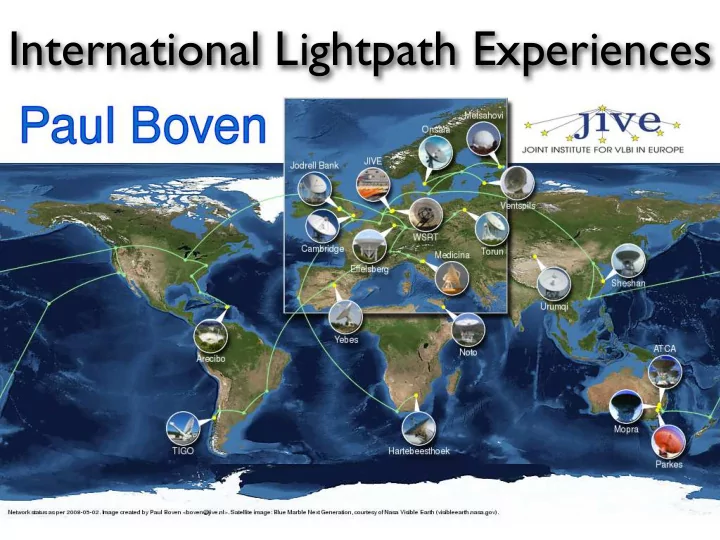

International Lightpath Experiences
Radio Astronomy Courtesy of NRAO
Radio vs. Optical astronomy The imaging accuracy (resolution) of a telescope related to its wavelength and diameter: θ ≈ λ /D Hubble Space Telescope: λ ≈ 600nm (visible light) D = 2.4m θ = 0.1 arcsecond Onsola Space Observatory: λ = 6cm (5GHz) D = 25m θ = 600 arcseconds Moon: 3x3 pixels
Very Long Baseline Interferometry • Create a huge radio telescope by using telescopes in different locations around the world at the same time • Resolution depends on distance between dishes, milli-arc second level • Sensitivity on dish area, time and bandwidth • Requires atomic clock stability for timing • Processed in a special purpose super-computer: Correlator, 16x 1024Mb/s
Very Long Baseline Interferometry • Initially (1990) we used large single-reel tapes • Then came harddisk-packs tekst tekst • And now: e-VLBI
Why e-VLBI • Quick turn-around • Rapid response • Check data as it comes in, not weeks later (You can’t redo just 1 telescope) • More bandwidth • Logistics (disks damaged/delayed/deleted...) Example: CygX-3 • Star + black hole • Flares irregularly • Timescale: days • Left: 2 weeks late • May: Observed flare with e-VLBI
TCP Research • Mirror port (span) • eVLBI: RTT up to 354ms • Window Size (kernel vers.) • SACK-bugs • Tuning defeats fairness • Conclusion: • UDP • Lightpath connections
Network Overview Telescope Bandwidth RTT Sheshan 512 + 622 LP 180ms / 354ms ATNF (2x) 2x 1Gb/s LP 343ms Arecibo 512Mb/s VLAN* 154ms TIGO 95Mb/s* 150ms Medicina 1Gb/s LP 29.7ms Onsala 1.5Gb/s VLAN 34.2ms Torun 1Gb/s LP 34.9ms Jodrell Bank 2x 1Gb/s LP 18.6ms WSRT 2x1Gb/s CWDM 0.57ms Effelsberg 10 Gb/s VLAN 13.5ms
The current e-VLBI network Connected stations and other EVN members
Our ‘last mile problem’... ... is usually more like 25 miles. Radio telescopes are located in ‘uninhabited’ places. A number of European telescopes do not have a connection yet.
JIVE Network Setup 5Gb/s IP connection 16x Mark5 server SURFnet WSRT 16x SURFnet lightpaths External switch/ GEANT router Internal Radio switch/ Telesopes router 0 1 2 3 Legend 10 Gb/s fiber 1 Gb/s fiber 10 Gb/s CX4 1 Gb/s RJ − 45 1024 Mb/s JIVE Correlator Serial links
JIVE Network Setup • A single class C (192.42.120.0/24) • Top /25: our servers • Bottom /25: connections for telescopes • No RFC-1918 • 16 e-VLBI servers each in its own /30
Security • Lightpaths often bypass firewalls • Performance, different administrative domains • We do not want to be the world’s largest ‘back-door network’ • Very simple access lists on L3-switch: • Telescopes can talk to JIVE servers • Can not connect to one another • Can not connect to outside world • Can not be contacted from outside network.
Lightpaths • Dedicated point-to-point circuit • Based on SDH/Sonet timeslots (NOT a lambda) • Stitched together at cross-connects • Guaranteed bandwidth • But also: a string of SPFs e-VLBI
Lightpaths • Especially the longer lightpaths have many outages • NRENs usually very good about announcing maint. • A -lot- of email. • e-VLBI is becoming a ‘target of opportunity’ instrument, planned and unplanned observations
One-way lightpaths • Two 1Gb/s lightpaths, but only worked UK → JIVE • Ethernet level debugging, mirror/span ports • PTEs from different vendors • Great support from NRENS • Set up a ‘detour’/break-out: • LP - ethernet - LP • Used UDP (set our Mac-addr at their switch) • Observed SN2007gr supernova • Turned out to be a CRC config mismatch, fixed
The 10 minute LOS • Initially three LP from ATNF (Australia) to JIVE • The long way round (via Hawai, Canada) - 343ms • Every 10 min.: LOS for 4 seconds, 2 minutes past • OZ: Far-End alarm • JIVE: path stays up (but 4s no data) • Every sub-part of the ligthpath works • Ethernet break- out at Canarie: lightpath works
Debugging VLANs/Lightpaths • Step one: figure out exact topology • Traceroute is of very little use • Check ARP tables at endpoints • Mirror / Span ports, tcpdump, CDP broadcasts • VLAN: pick some RFC-1918 space, assign IP to every switch, see who you can ping • Check MTU at every hop (we need Jumbos!) • Lightpaths: create a lot of traffic (e.g. CBR UDP) • Check interface counters/graphs (5 min RRD ☹ ) • Make ‘breakouts’ or ‘loopbacks’
Finally • e-VLBI: • Research subject • Astronomical instrument • Requires a broad mix of networking technologies: Lightpaths, VLANs, routing, CWDM, bonding, multicast, 1GE and 10GE, ... 2008-11-19: First use of 1024Mb/s in science observation
Even more finally • This week, 4/5 december: full 24 hour observation, 3 science projects, European telescopes + Sheshan • Opening International Year of Astronomy 15/16 january 2009 • Many outreach/educational activities • Global e-VLBI observation
Recommend
More recommend